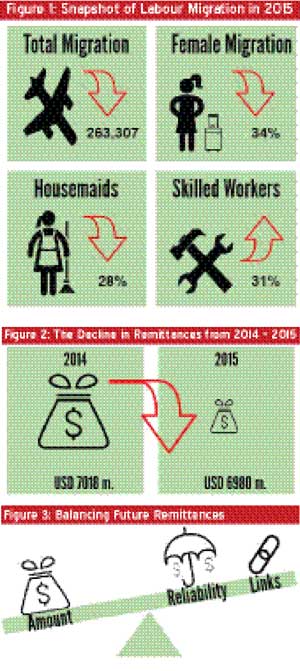19 Dec 2016 - {{hitsCtrl.values.hits}}

Labour migration and related remittances play an important role in the Sri Lankan economy. Until recently, labour migration from Sri Lanka was dominated by females departing as housemaids. Subsequent to many concerted policy efforts, such as the Family Background Report (FBR) requirement, pre-departure training and upgrading the existing skill training to internationally recognized levels, this female and low-skilled-oriented migrant worker flow is now transformed into a more skilled and male-centric flow.
As a result, in 2015, the sphere of labour migration experienced many changes. In 2015, the total departures declined to 263,307 from 300,703 in 2014, the share of females among migrant worker departures further declined in 2015 to 34 percent from 37 percent in 2014 and the share of housemaids also continued to shrink to reach 28 percent in 2015 from 30 percent in 2014.

In fact, 2015 marked the first year since 1994, where the share of housemaids dipped below that of skilled workers (31 percent). The other skills groups, such as professionals and semi-skilled groups also experienced growth to reach shares of 2.4 percent and 2 percent, respectively.
This gender reversal and upskilling of migrant workers, coincided with the first-ever decline in inward remittances in 14 years. In 2015, the inward remittances to Sri Lanka declined to US $ 6,980 million from US $ 7,018 million received in 2014. Does this 0.54 percent decline in remittances mark the beginning of the downward trend in remittances to Sri Lanka? Let’s hopes not!
Nonetheless, since such wishful thinking alone will not guarantee a steady flow of remittances, it is only prudent for Sri Lanka to proactively understand the possible underlying mechanisms that may contribute to positive and negative changes in remittances and introduce measures to maximize remittances. To that effect, the remainder of this article identifies five mechanisms that affect remittances and makes related policy recommendations to ensure a continued steady flow of inward remittances to Sri Lanka.
Mechanism 1: Shrinking share of reliable remitters
Literature identifies that compared to males, females are more reliable remitters. This reliability stems from the greater involvement of females with the operation of the left behind household and their tendency to sacrifice more than males for family back at home. Additionally, females also tend to remit more as a self-insurance mechanism against possible negative shocks at destination. The recent policy efforts to discourage the departure of female workers have inadvertently also contributed to reduce the number of reliable remitters to Sri Lanka.
Mechanism 2: Growing share of high-waged remitters
Despite being less reliable, when they do remit, males are noted to remit more. The reason behind such higher remittances from males is due to their capacity to earn higher wages than women in similar jobs. This has the potential to offset the less reliability of male remittances with larger amount of remittances when they do remit.
Similarly, the progressive upskilling of migrant worker from Sri Lanka also contributes towards a rising share of higher wage earners among all migrant worker departures and their corresponding higher remittances.
Mechanism 3: Increasing departure of tied migrants
There is evidence that migration of skilled workers is often associated with tied migration – where the spouse accompanies the migrant workers. In a patriarchal society like Sri Lanka, when the male migrant worker shares are rising, there is a higher tendency for tied migration of wives to take place. Similarly, regardless of gender, better skilled migrants also tend to induce tied migration from Sri Lanka. Extending this tied migration beyond spouses, better skilled migrants from Sri Lanka are also enticed to take their children especially to enjoy higher education options overseas. All this amounts to the absence of immediate family members to receive regular remittances.
Mechanism 4: Shrinking importance of circular migration
Another aspect of skilled migration is that the better skilled migrant workers often have opportunities to pursue other destinations to migrate subsequently. This may alter the circular nature of labour migration from Sri Lanka towards a pattern of step migration where migrants leave the first destination not to return to Sri Lanka but to head to a second destination. The decline of circular migration and rise in step migration would also lead to weaker links with the home country and a corresponding decrease
in remittances.
Mechanism 5: Growing possibilities for long-term migration
Despite being recognized as temporary migrants, high-skilled migrants tend to continue foreign employment for multiple contract periods. Such residence and employment in destination for extended periods resemble more permanent characteristics of migration. As a result, such extended stays also lead to weaker links with the home country and a corresponding decrease in remittances.
How to maximize remittances?
In the context of gender reversal and upskilling of labour migrants, as summarized in Figure 3, the receipt of higher remittances are challenged by two sets of competing forces.
On the one hand, the rising share of males among migrant workers would lead to greater remittances to Sri Lanka only if the monetary value of their remittances can offset their less reliability in remitting. Similarly, in the case of the rising share of better skilled workers among migrant workers, greater remittances would only occur if higher wages and related remittances can offset their weaker links with Sri Lanka.
In order to make these competing forces work towards maintaining a high inflow of remittances, some policy approaches are a dire need. Aptly the National Labour Migration Policy of 2008 identifies that ‘the diversity of Sri Lankan transnational communities requires differentiated approaches between skilled and professional workers and low-skilled workers and ethnic communities, permanent and long-term migrants and temporary migrant worker’. The same policy identifies action plans for:
n Reviewing the existing incentives for migrant savings and investments and access to credit,
nDeveloping and implementing a framework to provide incentives for skilled and professionals to contribute to home country development from abroad through; investment opportunities, tax benefits, etc., and schemes for ‘giving back’ to the country’s development.
With the experience of a decline in inward remittances to Sri Lanka in 2015, now is the ideal time to transform the above policy plans into actions. Additionally, Sri Lanka should also deploy differentiated approaches between male and female segments of Sri Lankan transnational communities and highlight the importance of ‘regular and reliable’ remittances from male migrant workers.
If such appropriate interventions take place in a timely manner, Sri Lanka would be able to revert to its growing trend and relegate the decline in remittances in 2015 to a mere glitch.
(Dr. Bilesha Weeraratne is a Research Fellow at the Institute of Policy Studies of Sri Lanka (IPS). To view the article online and comment, visit the IPS blog ‘Talking Economics’ – www.ips.lk/talkingeconomics)
10 Jan 2025 18 minute ago
10 Jan 2025 35 minute ago
10 Jan 2025 55 minute ago
10 Jan 2025 2 hours ago
10 Jan 2025 2 hours ago